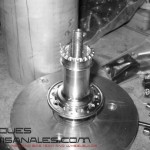
Close to the dark forest, the industrial zone of Buggingen concentrates cutting edge companies. Tune built its factory here about 15 years ago after a few years of activity at the owner’s home. Continuer la lecture

Close to the dark forest, the industrial zone of Buggingen concentrates cutting edge companies. Tune built its factory here about 15 years ago after a few years of activity at the owner’s home. Continuer la lecture
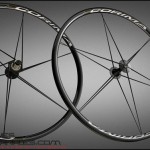
We are getting very close to it… still only three days of wait before the Eurobike, 2009 edition! We will cover the event as the last year, with a complete article every days, about the main brands, or about the brands pushing the enveloppe. We will do our best to translate all of them in french/english, if possible. Continuer la lecture
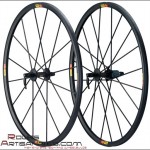
The brains are hot in Annecy. Unhappy to offer an extremely versatile wheelset with its Cosmic Carbone Ultimate, Mavic is going to release a super light weapon: the R-SYS
Ultimate. The ultimate evolution of the R-SYS unveiled in 2007 (HERE). Continuer la lecture
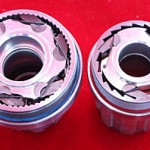
Sea Otter exhibition, USA, revealed some new products such as the new SRAM FORCE group and confirmed some others. Most of the following featured products, will be available for 2010. Continuer la lecture
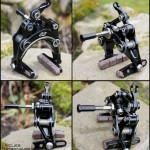
They are worth a comparizon with the Terminator T800. EE Cycle Works brake calipers look very agressive.
Cleverly thought, the EE brake design was optimized with extensive use of finite element analysis. This method helps to find « the » best solution, the best compromise. Continuer la lecture
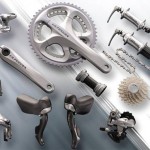
Ultegra 6700
The group « second of range » from Shimano is having a complete update. This Ultegra 6700 replaces the Ultegra 6600 and Ultegra SL. The benefit is 151g on the 6600 and 44g on the SL. Prototypes have been under testing since Febuary. The final version is therefore introduced this week. Continuer la lecture

Groupe Ultegra 6700
Le groupe « second de gamme » de chez Shimano a subit une refonte totale. Cet Ultegra 6700 remplace l’Ultegra 6600 et l’Ultegra SL. Le gain est ainsi de 151g sur le 6600 et 44g sur le SL. Continuer la lecture
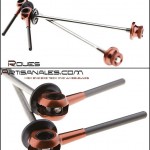
Please have a look at the contest Light-bikes.de is doing.
They are electing the bike of the year 2009. Only road bikes under 6kg are accepted, other limits are fixed for cross and MTB bikes. Continuer la lecture
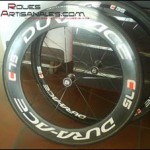
We mentionned them some weeks ago. Shimano is renewing its wheel range for the next year 2010. The 35mm deep wheels, 50mm and 75mm are new or renewed.
At first sight, the 50mm rim doesn’t seem to be receiving technical updates, but the two others are all new. Continuer la lecture
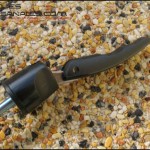
Our bike’s quick releases are important safety parts. We can find them within a wide price range, made with different materials, offering more or less clamping strength. First of all, let’s look at the stress the skewers have to deal with. Continuer la lecture
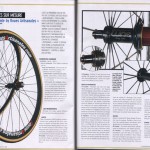
You will find in this section the press article speaking about our custom handbuilt wheels work since the website was created. The pro and amateur riders riding our wheels we wish to sponsor will also be mentionned Continuer la lecture
Continuer la lecture
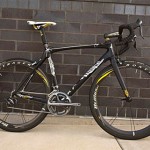
This year Rotor sponsors the new team Cervélo. Some pro racers of the team in which 2008 Tour de France winner Carlos Sastre is, now test the latest Rotor crankset equiped with the Quarcq powermeter. During the bike presentation, Josu Mondelo, Arueda.com could take some pictures of this prototype. Continuer la lecture
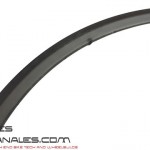
Edge Composites
American carbon fibre component manufacturer is updating its rim range. A new rim will show up very soon, and a rim is slightly upgraded. Continuer la lecture

The famous french wheel manufacturer recalls every R-SYS front wheels. The fragility of the spokes and the TraComp system make this wheel particularly dangerous. Indeed it collapses completely as something hits a spoke. Mavic plays safety here and will replace every spokes with a stronger and thicker model. Continuer la lecture

|
Interbike Parlee FWB This was one of the most special bike displayed at the Interbike Expo in the United States: a Parlee frame and very high end components coming from the most prestigious manufacturers such
More pictures here: Lightweight, clincher version in test… The very first clincher Lightweight wheels are under production. With only a couple of wheelset per week, they are sparingly delivered. Our german colleague Light-bikes.de is currently Light-bikes.de (german)
Shimano The Di2 electronic groupset caused a stir at the Eurobike Expo, then at the Interbike fair trade too. Nevertheless, we are not really convinced an electric groupset can be useful for a road
Shimano is having punctures issues with the 7850 C24CL and C50CL wheels. Indeed they are coming with plugs instead of a standard rim tape to save weight, but those small components are File to be downloaded here: Shimano rappel |

|
Interbike Parlee FWB Voici un des vélos les plus en vue pendant le salon Interbike aux Etats-Unis: un cadre Parlee, des composants en provenance des constructeurs les plus prestigieux tels que Ax-Lightness,
Plus de photos ici: Lightweight à pneus en test… Les premières Lightweight à pneus sont en pleine production. A raison d’une poignée de paires par semaine, les livraisons s’effectuent au compte-goutte. Notre confrère allemand Light-bikes.de (allemand)
Shimano Le groupe électrique Di2 a fait sensation à l’Eurobike, puis à l’Interbike. Nous ne sommes pas pleinement convaincu de l’utilité d’un groupe électrique pour un vélo de route… En revanche,
Shimano connaît un problème délicat de crevaison sur ses roues haut de gamme 7850 C24CL et C50CL. Fichier à télécharger ici: Shimano rappel |

|
Nous n’avons malheureusement pas pu nous rendre sur le salon de l’interbike aux USA, nous avions besoin de quelqu’un sur qui compter pour collecter les informations et les photos de Las Vegas. Et quelle personnage! Le gars est passionné par le cyclisme, c’est un photographe de carrure, en tout cas de notre point de vue car toutes les photos semblent avoir le petit plus qui fait la diffèrence avec les photos habituelles. Le travail effectué par Rasmus T. Nielsen est sublime et il s’est même payé le luxe de créer une gallerie complète des photos de l’Interbike 2008. Si vous souhaitez voir les photos immédiatemment, suivez ce lien: Interbike 2008. Si vous avez aussi besoin d’informations, n’hésitez pas à lire ci-dessous. Industry Nine Il s’agit certainement des plus belles roues de la planète. Elles disposent d’un corps et de rayons en aluminium anodisé, vissés directement dans le moyeu, et d’un système de roue libre
Site constructeur: Industry Nine Edge Composites LLC Edge dispose d’une large gamme de tubes pour cadres de vélo, de jantes et étend son offre aux tiges de selles et cintres. Notes
Site constructeur: Edge Composites Linskey Mark Lynskey est certainement l’un des personnages les plus à même de travailler le métal pur. L’histoire a débuté en 1986, quand les premiers cadres sortirent des ateliers. La compagnie a
Site constructeur: Lynskey Performance Powertap Powertap est dorénavant bien connu pour ses capteurs de puissance. Saris a trouvé de précieux alliés tels que Mavic et sa Cosmic Carbone Pro, Reynolds avec des options pour ces capteurs,
Site constructeur: Saris EE Cycle Works Après M5, Zero gravity, EE Cycle Works développe un frein aluminium très spécial. Le frein semble définitivement axé sur la fonctionnalité plutôt que sur la forme. Le tout sans oublier le
Site constructeur: EE Cycle Works |

|
Interbike is the North America’s largest bicycle trade event and show takes place in Las Vegas during 3 days from the 24th to the 26th of September. With over 1,000 of the top brands and nearly 23,000 attendees from over 60 countries, it is similar to the Eurobike in Europe. Several manufacturers did keep secret some of their newest products and unveil them at this event. Ritchey The giant american manufacturer is updating its wheel range with the Superlogic Carbon Road wheelset, featuring exclusive rims, made with uni-directional, 100 % high-modulus carbon
Cervélo Cervélo releases a newer version of the time trial/triathlon frame. The P4 is claimed to be the fastest ever made bicycle including the UCI legal and UCI illegal bikes. The fork is a custom Every single details can be read on Cervélo’s website, or on BikeRadar.
Rotor
Chris King Chris King is well known for its legendary life durable components. This year is an important year for the american manufacturer. Chris King finally releases a new bottom bracket which is
Chris King also was busy with new hubs: Single Speed road versions, thru axle 10mm and 12mm MTB versions, two 15mm thru axle front options.
|

|
The last fall, we featured the Edge Composites rims made in USA (see here). Since this article, the company based in Ogden extended its rim range: the clincher rims are on the market since a few weeks, and the first flat section rims are being delivered.
The Edge range is now composed of three models: 24mm, 38mm, 68mm. The two last are coming in 1 and 2 version, and in clincher version too. The rims have no spoke tension limit thanks to the molded spokes holes. So we could easily put 1150N of spoke tension on the drive side of the rear wheel. Basically, this is not
The Edge Composites rims descend from the Lew racing fabrications. Several manufacturers did benefit of this construction: Reynolds, Shimano, Easton to quote the most Well these 1.24 rims are under test. If the perform well, we will add them to the boutique. |

|
Eurobike, second part on the bike component we appreciate the most, i.e. the wheels. Lightweight First, Lightweight the famous wheel manufacturer, updates, or releases new components:
DT Swiss DT updates its spoke and hub line. Most of the new stuffs are for MTB, but the road range is concerned too. First the Aerolite spokes are available in white, as well as the 240s hubs.
Tune We believed Tune pushed the enveloppe quite much with the Mag130 weighting only 137g. It looks like it is not the only thing, the Mag110 was presented as a prototype too! The rear hub is
THM Thm definitely has good ideas. The new aero Scapula has a brake integrated. It seems pretty powerful and we are confident into this.
Zipp Zipp improves its rear wheel with a Mavic like spoking: radial on the drive side, and crossed on the other side. The 255 rims have now there nipples external.
SRAM The merge with Zipp allowed SRAM to make wheels. They are pretty similar to Flashpoint Zipp wheels but with different hubs.
|

|
Convexo Convex. This barbaric name self explains the physical phenomenon Paul Lew, forerunner in bicycle wheels world, relied on for his newest invention. This time-trial disc wheel differs from the others by its shape, which converges on the rear, and features the swirl lip generator reducing the crosswind sensivity. The tests performed in a windtunnel, proved this double convex disc wheel to optimize the aerodynamic of the rider plus bike system: it reduces the drag, so the power needed to ride at a given speed.
Convexo Convex
In theory This wheel pushes the limit of the disc design to a new standard. Where the flat sided disc wheels create a lot of turbulences, a lens shaped disc wheel, by its curved shape on the non « For a minimal drag, the perturbated air flow must converge behind the rider« , Paul Lew told us. This is here this wheel differs from the others, the Convexo Convex is curved on both sides. This special shape helps the air flow, perturbated by the presence of the rider and its bike, to On the right, the flat sided ovoïd rim disc wheel, such as a Zipp Sub9, has the airflow perturbated behind it because of the flat flanges. On the left, the airflow of the Convexo Convex wheel converges and leaves the system as a clear flow, synonym of low drag, so better aerodynamic properties.
In practise The tests performed at Mooresville, North Carolina, USA, recorded thousands datas. The wheels claimed to be the fastest of the market were tested on the bench. The results are summarized in the table below:
Regarding the wheels only, Zipp is indeed the fastest: 12% less drag for the front wheel, and 53% less drag for the rear wheel! The difference is significant and corroborates the datas
A few points are important here: with a yaw angle of 10°, the Zipp404/Zipp Sub9 configuration is as fast as the Lew Pro VT-1/Convexo Convex, taking into account the measure errors. At yaw 20°, the configurations « full » Zipp or « full » Lew are as fast, when taking into account the errors. Weirdly the fastest configuration at 10° is the slowest at 20°.
Only Zipp wheels, among the current fastest wheels have face the Lew in this test. What’s on the scale? Of course, as every products coming from the Lew factories, the components are extremely light. The carbon and boron wheel, lens shape, is 780g. As comparizon, the Lightweight Disc, flat
|

Extralite 2009
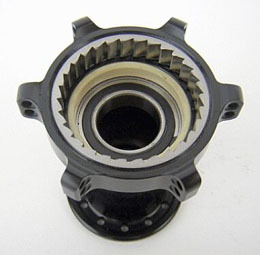 Extralite released the front SX hub some months ago. The italian company is now unveiling the rear version. Straight pull spokes and J bent spokes will be required to build this
Extralite released the front SX hub some months ago. The italian company is now unveiling the rear version. Straight pull spokes and J bent spokes will be required to build this
lighter than ever rear hub.
As stock components, Extralite offers a hubset weighting in only 183g, 49g the front, and 134 the rear, which is the weight of a very light rear hub, such as the Tune Mag180 (185g) or DT190
Ceramic (192g).
Before building Extralite hubs, we wondered how it was possible to make so light aluminium hubs: the stock Extralite SR is 155g, without losing resistance, nor reliability…
It was obvious after disassembling an SR hub. First, the diameter of the axles of these super light rear hubs is multishaped: between 15 and 17mm. Second, the bearings are pretty big: 6803
and 6804, which is very rare on stock wheels. Third, the hub shell to rotor junction is running through two « plastic » discs, sliding onto each other, which is pretty similar to what Mavic
uses. Last but not least, the play setting is done by hand with the micro-tuner, a knurled plastic bolt. So light, easy and efficient!
The Extralite rear hubs are, from our point of view, extremely well designed.
However, although being ultra light and reliable, they will obviously remain less durable than most heavier competitor hubs. There are at least two causes:
– the two plastic discs sliding onto each other should, in theory, wear faster than a complete bearing. At Tune, this junction is realized by a double bearing, based on a 6802/6902
whose internal race is similar.
On a high end DTSwiss, this junction features two extremely resistant « ratchets », and two springs pushing them against each other.
– Then, the Extralite rotors only have 2 engagement pawls, which are quite thin, to transfer the torque to the hub shell. As comparizon, Tune uses 3, PMP too. Regarding the biggest
wheel manufacturers, Campagnolo equips its freewheels with 3 pawls, Mavic only two, but those are quite wide.
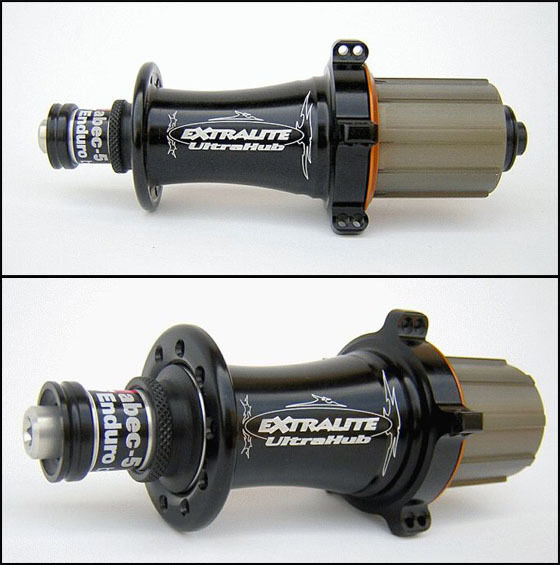
Regarding the design, the Extralite UltraRear SX requires straight pull spokes on the drive side, and standard J bent spokes on the non drive side. Why? Extralite claims a better stiffness
and reactivity. We will keep in mind removing the axle is not required anymore to lace the radial spokes of the non drive side.
The geometry is optimized for Shimano: the right side end nut is shorter than the Campagnolo one, and allows wider bracing angles, thus a stiffness gain.
From a weight point of view, this hub is claimed to be between 134 and 136g depending on the drilling. We are waiting for the first model to test and eventually offer them in the boutique
if we are satisfied.
Extralite range
| Front hub | Rear hub | |||||
| Model | UltraFront SX | UltraFront SL | UltraFront SP | UltraRear SR | UltraRear SP | UltraRear SX |
| Material | AL7075TX & GRD5 Titanium | AL7075TX & GRD5 Titanium | AL7075TX & GRD5 Titanium | AL7075TX & GRD5 Titanium | AL7075TX & GRD5 Titanium | AL7075TX & GRD5 Titanium |
| Spoking | J-bent spokes | Straight pull spokes | Straight pull spokes | J-bent spokes | Straight pull spokes | Straight pull spokes/J-bent spokes |
| Bearings | 2×6801 | 2×6803 | 2×6801 | 2×6803/6804 | 2×6803/6804 | 2×6803/6903 |
| Axle | 14mm | 17mm | 14mm | 20/17mm | 20/17mm | 17mm |
| Weight | 49g | 62g | 49g | 155g | 150g | 134g |
| Price | 149 euros | 149 euros | 149 euros | 349 euros | 389 euros | 399 euros |
Tune 2009
Some informations about Tune 2009 were unveiled on our fellow member Light-bikes.de website. The main news concern the MTB hubs with the X12 system allowing very easy wheels installations/
A new color will be added to the already very wide color range at Tune: red/blue/black/silver/pink/orange/green!
The Mag140 which was under development since two years old is finally added to the catalog. It will keep the shape of the Mag150, current high end rear hub, but with a couple of
upgrades to save a few grams.
A new prototype is under development. It is also based on the Mag150 design, but it pushes further the limits. 137g …
We invit you to have a look at the german website for more information.
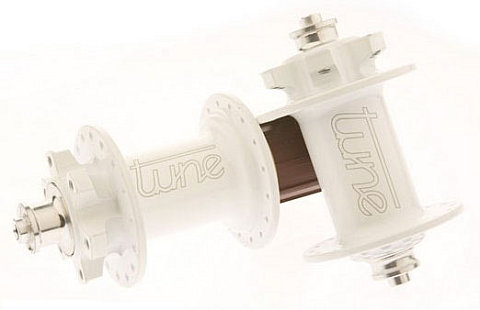

|
Convexo Convex. Un nom barbare qui explique à lui seul le phénomène physique sur lequel s’est appuyé Paul Lew, précurseur dans le monde de la roue, pour sa dernière invention. Cette roue de contre-la-montre diffère des autres par sa forme, qui converge en sortie, et reprend le concept mis en place sur la jante Pro VT-1, à savoir le petit épaulement qui réduit la sensibilité de la roue aux vents latéraux. Les tests effectués en soufflerie, ont montré que cette roue lenticulaire permet d’optimiser l’aérodynamisme de l’ensemble coureur plus machine: réduction de la traînée, donc la puissance à fournir pour une vitesse donnée.
Convexo Convex
Cette roue pleine met donc en avant le concept de la roue lenticulaire poussé à l’extrême. Là où une roue paraculaire est parfaitement plane et crée beaucoup de turbulences, une roue « Pour une traînée minimale, le flux d’air perturbé par le coureur doit converger en sortie » nous confie Paul Lew.
C’est à ce niveau que cette roue fait la diffèrence avec d’autres, la Convexo Convex est bombée des deux côtés. La forme spécifique de la roue permet au flux d’air perturbé par la présence Sur la droite, la roue paraculaire avec jante ovoïde, type Zipp Sub9, voit le flux d’air perturbé en sortie à cause du flasque plat. Sur la gauche, le flux d’air de la roue Convexo Convex converge et sort en un flux unique synonyme de faible traînée, donc d’un meilleur aérodynamisme.
En pratique Sur les tests mis en place à Mooresville, en Caroline du Nord, USA, une multitude de valeurs sont enregistrées. Plusieurs roues, celles censées être les plus rapides à l’heure actuelle, Nous vous résumons donc les résultats les plus intéressants concernant les roues seules dans le tableau ci-dessous:
En ce qui concerne les roues seules, Zipp est bien le plus rapide: 12% de traînée en moins sur la roue avant, et 53% sur la roue arrière! La diffèrence est assez significative et corrobore
Plusieurs points sont importants sur ce tableau: sur un angle d’attaque du vent de 10°, la configurations basée sur du Zipp404/Zipp Sub9 fait jeu égal avec la configuration Lew Pro A 20°, les configurations « full » Zipp ou « full » Lew font jeu égal, aux erreurs de mesure près. Etrangement la configuration la plus rapide à 10° s’avère être la plus mauvaise à 20°.
Seules les roues Zipp, parmies les plus aérodynamiques à l’heure actuelle, ont fait face aux Lew dans ce test. Et la balance? Evidemment, comme tous les produits sortant des usines Lew, les pièces sont extrêmement légères. La roue, de carbone et de bore vêtue, lenticulaire, atteint les 780g. A titre de |

|
Issues des fabrications de Heinz Obermayer et Rudolf Dierl, puis reprises en 2003 par Erhard Wissler à la tête de Carbon-Sports, ces génération 3 bénéficient de presque 15 ans d’expérience La perfection, oui, et quelle perfection! Le premier point qui surprend en prenant une paire de Lightweight génération 3 en main, est l’intégration de tous les composants entre eux, et la Bref, cette dernière évolution des roues Lightweight reprend donc le concept des doubles rayons moulés dans la jante et enroulés autour du moyeu. La génération 3 met en avant des rayons
Sur la route, quelles impressions? Rigidité/Inertie Autant le dire de suite: nous étions resté sur une impression moyenne de rigidité latérale de la part des Lightweight Obermayer génération 2, mi 2007. La jante flottait entre les patins et
Aérodynamisme et prise au vent
Lors des vents de travers, la force d’Eole pousse la jante avec une surface tellement importante que le guidon « cherche à tourner » constamment. Rien de très dangereux ici, le coureur En revanche les rafales soudaines peuvent s’avèrer bien plus dangereuses car le coureur ne ressent pas la nécessité de maintenir le guidon fermement et il s’écarte donc de sa trajectoire Nous avons pu remarquer aussi qu’en virage rapide, les Lightweight tendent à nous attirer vers l’extérieur du virage, comme si elles refusaient de virer et nous déportaient. D’après Comparatif des quatre paires de roues les plus haut de gamme du marché Les sensations que nous avons eu sur ces Lightweight Standard, en terme de rigidité et d’inertie sont très proches des Mavic Cosmic Carbone Ultimate. Ces dernières nous laissent Depuis plusieurs mois, nous avons eu la chance de pouvoir tester les quatre paires de roues les plus haut de gamme du marché, voici donc la table comparative de leur propriétés. Les données
Les notes sont données sur une échelle de 5. Plus la note est élevée, meilleure est la prestation
|

|
Descending from Heinz Obermayer and Rudolf Dierl’s pioneering constructions, Lightweights were continued in 2003 by Erhard Wissler, head of Carbon-Sports. These generation 3 hoops benefit The perfection, yes it really is perfect! The first point which surprises when picking up a set of Lightweight generation 3s is the level of integration of every component, the dramatic In short, this latest evolution of the Lightweight wheels still is using the concept of the double spokes molded into the rim, and wrapped around the hub. The generation 3 features full
How do they ride? Rigidity/Inertia We were not ecstatic about the lateral stiffness of the Lightweight Obermayer Generation 2, mid 2007. The rim moved a lot between the brake pads, and we did not really understand why
Aerodynamic and wind handlings
When the wind is blowing from the side, it pushes the rim with a so high surface that the bars tends to make you change direction constantly. This is not really dangerous since the rider Nevertheless, sudden gusts can be much more dangerous because the rider may not really hold the bars securely and it makes him change direction. In descents, we realised the Lightweight wheels tend to pull the bike to the exterior of the quick corners. It’s as if they refuse to corner and prefer to continue in a straight line. Comparative of the four most high-end wheels of the market The feelings we had while riding these Lightweight Standard, in term of stiffness and inertia, were very close to the Cosmic Carbone Ultimate. However these French wheels felt one step Since a few months, we have had the chance to test the four best wheels of the market, here is the comparative table. The data in this table is based on our qualitative impressions riding
The marks are given on a scale of 5. Higher is the mark, better is the performance. |

|
In 2007, Mavic released a new wheel concept. The TraComp technology pushed the French manufacturer at the top of the high-end aluminium range. In 2008, the company from Haute-Savoie is releasing another system, which seems as promising, and should open doors to several further upgrades in subsequent ranges. The SLR version of the Cosmic Carbone is the first wheelset to benefit from the R2R concept. The aluminium rim is still equipped with the carbon twill weaved
R2R, a promising concept
Regarding the materials, the SLR spokes are unidirectional carbon. However they differ from the spokes of the Ultimate version on several points. Oval and looking raw on the Ultimate, their
The advantage of the concept is indisputable: it is the first « rim to rim » carbon spoked wheel, fully repairable, spoke by spoke. Exaggerating slightly, we could even say it’s a Cosmic Evolutions at every level The components of the CCSLR remain visually identical to the previous Cosmic Carbone. Nevertheless the aluminium rim is lightened of 20g between the spokes, which translates into lower
The hub is obviously redesigned to receive the R2R spoking passing through each flange. Still made out of aluminium, the hub receives the usual Mavic mechanism. The bearings are smooth but
Carbon spokes, comparizon Finally, we have to conclude that Mavic has, once again delivered a useful innnovation. It is the first full carbon, rim to rim spoking, coming along with lightness: the CCSLR are 145g |

|
What’s that?
The Powertap is one of the required tool for a good quality training and a whole follow-up of the performance. This device is a power sensor integrated into a special rear hub which is For the story, we wanted to test this device before offering it in the roues artisanales boutique. The racers and sportive riders, who wish to improve their performances and have a real
How does it work?
The rider creates a torque which is associated to a pedaling frequency. The torque (spinning force so it’s in N.m) multiplied by this speed (rad/s) is a power in Watts. The comptuter The power meter displays instantaneously the power on a special comptuter. Beside the power, speed, pedaling frequency, hearth rate, odometer, we enjoied the torque display during the high The settings are a bit more complicated than with a standard comptuter. Indeed, we had to modify the power refresh display from 1s to 2s because the variations were too quick. Although we
Power Agent, the software A special software is provided with the device. It helps to analysis into the details the ride/race. The comptuter can record several trainings, as long as the total is not longer than 15
Some principles… Here are some power figures depending on the rider level and the effort. The distances the riders can hold those power levels obviously get bigger with higher level athlets. For example, a
The range Three range is composed of three models. Basically, they all offer the same things in term of precision and functionnality: the error margin is 1.5%, the hub shell is in carbon/aluminium, Conclusion Finally, the apparel gave us complete satisfaction. It is a training device, which can be very useful for racers or cyclosportives looking for higher performances, to improve their maximal |

|
Zipp
Zipp is updating its handlebars range for 2009. The american brand unveiled 32 new bars, redesigned and passing successfully the EFBe tests. The three models, whose brand new Contour, are
SL – Super light. Super stiff SLC2 – The versatile bars Contour SL – The stage racer’s bars Sonic Sonic is offering a special version of its 50mm tubular wheels for the Tour de France. The yellow stickers are matching the gold nipples. The hubs are black instead of silver, the spokes Quick releases, wheelbags, brake pads and valve extenders supplied. |

|
June has been a busy month for news so far. It looks like the biggest players in the industry all unveiled their plans within a couple of days! Shimano, Time, Scott, Campagnolo, today Mavic, and in a few days Lew and Zipp! Cosmic Carbone SLR
Although the Cosmic Carbone SLR visually have the same rims as the normal version, the Cosmic Carbone SL, they are lightened by 20g thanks to extra milling of the aluminium rim, underneath R2R spoking
The Cosmic Carbone SLR wheels are claimed to be 1595g with 20 front and rear full carbon spokes, aluminium hubs, rims 20g lighter than the current version, and equipped with the R-SYS Premium
In short, it’s a well thought out system which deserves a significant update for the 2010 range. That’s our hope. Carbon hubs, carbon TraComp ring, beside the front aero spokes would be The R-SYS Premium have some small different details from the standard version: the rear hub is delivered with titanium screws, and the hubs caps are in carbon.
Cosmic Carbone SL 2009 The Cosmic Carbone SL is now more than 10 years old and Mavic is focusing on more competitive pricing for its oldest wheelset: they are about 30% cheaper than the 2008 version. They receive
Ksyrium Elite 2009 The Ksyrium Elite receive several updates. The rim is milled between the spokes holes, reducing the rim inertia by 30%, the hubs are redesigned to save weight, the rear rim is
Comete Finally, the time trial wheel, the Comete is 13% lighter thanks to new HM carbon flanges. The wheel is 1150g.
There more news to come about Mavic’s 2009 wheel range, however we can’t really tell you more right now. We just can tell you that some wheels are equipped with Powertap… wait and see! |